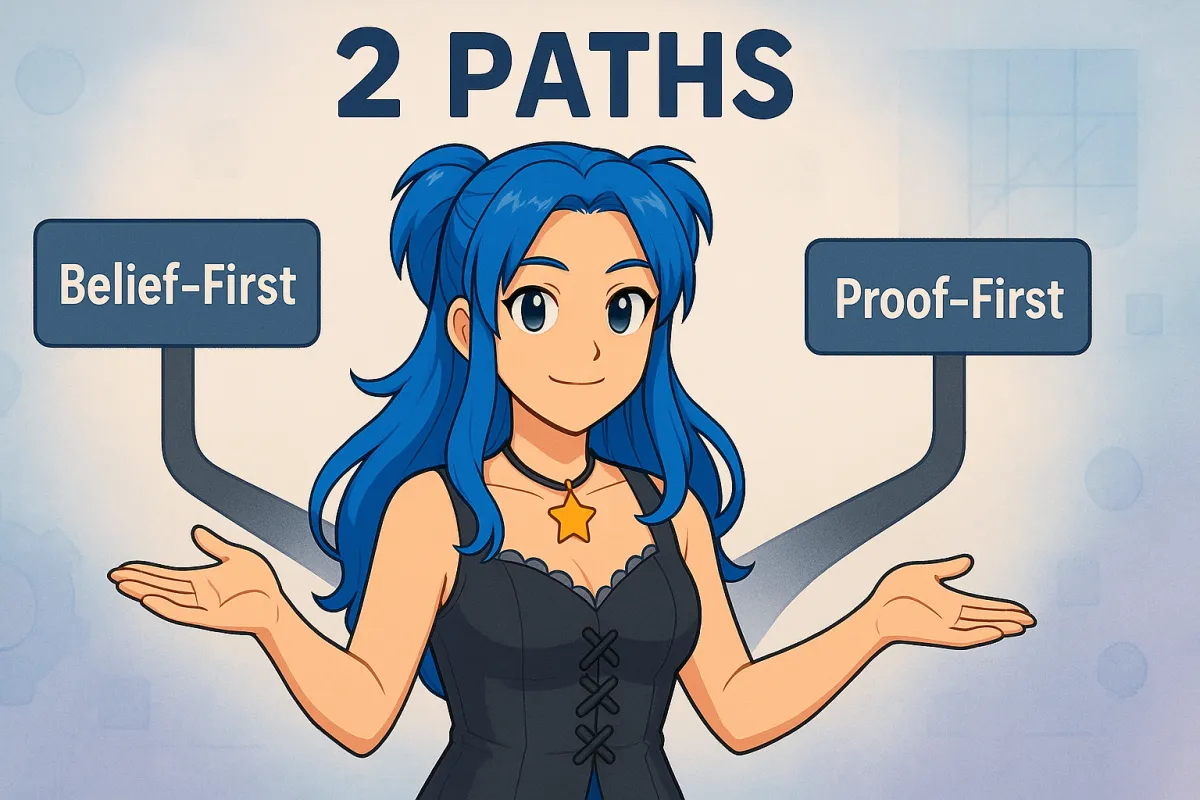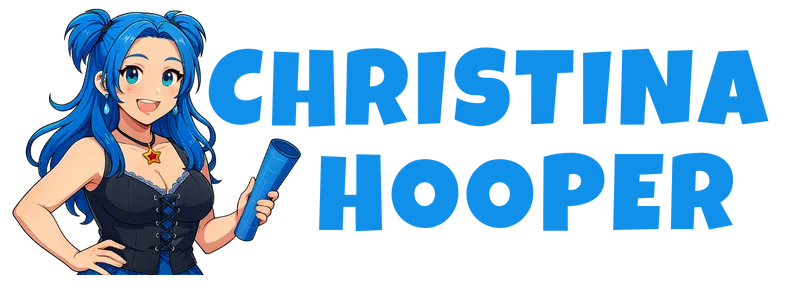
Can't Charge What You're Worth? Here's Why (And the Fix)
"Who would you be if the money were chasing you?"
I saw this question recently from Dan Sullivan, and it stopped me in my tracks. Not because it inspired me — but because it frustrated me.
I've heard variations of this message my entire entrepreneurial journey. "Stop chasing money and let it chase you." "Become a money magnet." "Just charge what you're worth." And for years, I watched other entrepreneurs embrace these concepts, double their prices, and somehow... it worked for them. They believed it. Their confidence shifted. Clients sensed it. Money followed.
So I tried it too. I'd psych myself up, decide I was worth more, and attempt to confidently state my new rate. And every single time, a voice in my head would immediately scream: "LIAR."
Not "maybe" or "are you sure?" but flat-out: "You're lying, and they're going to know it."
If you've experienced this — if every attempt to "just believe in yourself" feels like trying to convince yourself the sky is purple — this is for you. Because here's what I've learned after 18+ years and helping hundreds of entrepreneurs through this exact struggle:
You're not broken. Your brain isn't failing at mindset work. You just need the evidence-based path instead of the belief-first path. And that's completely valid.
The Two Paths to the Same Destination
Here's the truth nobody talks about: There ARE multiple ways to develop genuine pricing confidence. The "magnetic money" shift is real — that moment when you stop chasing desperately and clients start pursuing you. When pricing conversations feel easy instead of terrifying. When you KNOW you're worth what you charge because it's true down to your bones.
But there are two fundamentally different paths to get there, and your brain determines which one you need.
Path 1: Belief-First (The Woo-Woo Path)
Some entrepreneurs can hear "double your prices" and just... do it. They work with a mindset coach who helps them do affirmations, manifestation work, or reframing exercises. They practice saying their new rate until their brain accepts it. They visualize abundance. They repeat "I'm worth $X" until they believe it.
And it works. Their confidence genuinely shifts. Clients sense that certainty and say yes. Money does start to chase them.
This isn't fake or imaginary. Affirmations work through cognitive restructuring — replacing negative self-talk with positive statements can actually reshape neural pathways over time. For brains wired to accept belief without requiring proof first, this path is powerful and valid.
Path 2: Proof-First (The Evidence-Based Path)
But other entrepreneurs need EVIDENCE before their brain will accept a new belief. When they try affirmations, their brain immediately argues back with contradictory data: "But you only charged $50 last time." "That client complained." "You don't have a degree in this." "Who are you to charge that much?"
For these brains — often analytical, pattern-seeking, shaped by past money trauma, or simply wired to require proof — the belief-first path doesn't just fail. It can make things worse, creating cognitive dissonance that feeds imposter syndrome.
These brains need evidence FIRST, then belief follows naturally.
Self-efficacy — your belief in your capacity to achieve specific goals — is built through four sources, with mastery experiences (firsthand success) being the most powerful. In other words: You don't need to believe it before you do it. You can DO it, accumulate proof, and THEN believe it.
Neither path is superior. Your brain tells you which one you need.
Why Your Brain Calls You a Liar (And Why That's Actually Smart)
Let me explain what's actually happening when your brain refuses to accept "I'm worth $X" without proof.
Your brain operates on confirmation bias — we actively seek information that confirms existing beliefs while ignoring contradictory evidence. This isn't a character flaw; it's how human brains work. If your past experience includes evidence that you're "not worth that much" — whether from previous low rates, rejected proposals, financial struggles, or even just societal messages about your industry — your brain has DATA supporting that belief.
When you try to replace that belief with an affirmation alone, you're essentially asking your brain to ignore all the evidence it's collected and just accept something new because you said so. For some brains, that works. For others, it creates a war between what you're trying to believe and what your brain knows as fact.
Your brain isn't sabotaging you. It's protecting you from building confidence on a foundation it perceives as shaky.
And if you have money trauma in your background — and most entrepreneurs do — this gets even more complex. Financial trauma creates responses similar to PTSD, affecting current money decisions even when the original trauma wasn't directly about money. Any trauma, even unrelated to finances, can profoundly impact your relationship with money because at its core, trauma leaves us feeling unsafe or unworthy. And what does money represent in our society? Worth and security.
So when your brain screens "LIAR!" at your new pricing, it might be saying: "I need more data before I can believe this is safe."
The Vicious Cycle
Here's where it gets even trickier for creatively-wired, analytical brains dealing with money anxiety:
The same brain patterns that make pricing confidence hard can also drive impulsive spending. You see a tool, a course, a coach, and think: "THIS will be the thing that fixes everything." You hire quickly, invest emotionally, and then sunk cost fallacy makes it incredibly hard to cancel subscriptions or programs you're not actually using.
This drains your cash flow, which makes pricing even scarier because now you're desperate. And desperate energy? Clients sense that immediately.
So you're stuck: Can't price confidently because brain won't believe it. Can't stop spending impulsively because brain is seeking solutions. Cash flow suffers. Desperation increases. Confidence plummets further.
You need a way to break this cycle. And for evidence-based brains, that means giving your brain the proof it's asking for.
The Evidence-Based Path: Building Confidence Through Proof
If you've gotten this far and recognized yourself in the "proof-first" description, here's the framework that actually works for brains like ours:
Step 1: Do the Math
Your brain needs a logical foundation before it can accept your pricing. So let's give it one.
"Charge what you're worth" is useless advice because it's circular — you don't know what you're worth, which is WHY you're struggling. Instead, calculate your minimum viable rate based on reality, not feelings.
Here's the formula I teach:
Start with your target annual take-home — the salary you need to live, save, invest, and actually enjoy life. Let's say $100,000 for easy math.
Double it to account for business expenses. Based on Profit First methodology, in most B2B service businesses, you take home about 50% of revenue as salary. The rest covers taxes, expenses, savings, etc. So $100k take-home = $200k revenue needed.
Divide by 42 weeks — NOT 52. This gives you 10 weeks for vacation, sick time, deep learning, and life. Because you're building a sustainable business, not a prison.
$200k ÷ 42 = $4,761 per week
Divide by 20 billable hours — NOT 40+. You're not spending all your time on billable client work. About half your time goes to marketing, networking, sales calls, business development, and taking care of your human needs (yes, bathroom breaks and meals count).
$4,761 ÷ 20 = $238 per hour minimum
This is your MINIMUM. Not your worth. Not your value. Your minimum for sustainability and freedom.
Here's why this works for evidence-based brains: It's not asking you to believe anything. It's math. Your brain can't argue with math the same way it argues with affirmations. The logic is sound: "If I charge less than this, I mathematically cannot achieve my goals."
That's a foundation your brain can accept.
Step 2: Make the First Promise
Now comes the scary part: Actually charging that rate.
This is different from "fake it till you make it" because you're not faking anything. You have a mathematical foundation. You're not pretending to be worth $238/hour — you're stating the minimum rate needed for your business to be sustainable.
Your brain might still argue. That's okay. You're not asking it to believe you're WORTH this yet. You're just following the math.
Make one promise to one client at your minimum rate. Just one.
Step 3: Deliver Exceptionally
This is where evidence-building actually begins.
Focus entirely on the transformation you create for this client. Pour yourself into their success. Track everything — what you do, what changes for them, what results they get.
This is your first mastery experience — firsthand experience of success, which research shows is the most powerful source of self-efficacy. You're not trying to trick your brain anymore. You're collecting data.
Step 4: Document Everything
After you deliver, follow up. What happened for them? What changed in their business or life? What was the actual value of what you provided?
Get a testimonial. Track the transformation. Calculate the ROI if possible.
This becomes PROOF your brain can accept.
Collecting evidence of accomplishments is crucial for combating self-doubt. Keeping records of successes helps silence the doubts that fuel imposter feelings. You're not asking your brain to believe you CAN create value — you're showing it that you DID create value.
Step 5: Repeat Until Your Brain Believes
Each client success adds evidence. Each testimonial is more data. Each transformation is more proof.
Eventually — and this timeline varies for everyone — you accumulate enough evidence that your brain stops arguing.
Acknowledging strengths and reframing attribution beliefs are key factors that mitigate imposter feelings. When you have five testimonials, ten testimonials, twenty case studies showing the value you create, your brain can't dismiss it as luck anymore. It becomes undeniable.
This isn't fake confidence. This is REAL confidence built on a foundation of proof.
The Shift: When Evidence Becomes Certainty
Here's what happens when you have enough evidence:
That "magnetic" energy everyone talks about? It becomes real. Not because you manifested it through affirmations, but because you genuinely believe it now — and your belief is grounded in evidence your brain can't refute.
People judge the persuasiveness and reliability of information based on the confidence with which it's expressed, and genuine confidence is communicated proportionally to actual knowledge and certainty. In other words: Clients can sense the difference between performed confidence and genuine confidence.
When you KNOW you're worth your rate because you have proof, you communicate differently. Your energy shifts. Pricing conversations feel easy because you're not trying to convince yourself anymore — you're simply stating a fact.
And that confidence? Clients sense it immediately. They say yes more often. They negotiate less. They refer more.
Money starts chasing you — not because of manifestation magic, but because you've built genuine confidence that naturally attracts and closes ideal clients at prices that let you thrive.
When to Use Which Path (Or Both!)
So how do you know which path your brain needs?
Try this right now: Say out loud, "I'm worth $[your ideal rate] per hour."
How does your brain respond?
Feels energizing and true? → Try the belief-first path. Work with a mindset coach, use affirmations, do the manifestation work. If your brain accepts it, that's your path.
Immediately argues back with reasons it's not true? → You need the evidence-first path. Do the math. Build the proof. Let belief follow evidence.
Feels uncertain but open? → You might benefit from both. Use the math to create a logical foundation, then use affirmations to reinforce what the evidence is proving.
Here's the thing: These paths aren't mutually exclusive.
Many successful entrepreneurs use BOTH. Math gives the logical foundation. Evidence proves it's working. Affirmations and mindset work reinforce and maintain it. The difference is the ORDER — proof-first brains need evidence before affirmations work, while belief-first brains can start with affirmations and let evidence confirm.
The Money Trauma Consideration
If you have financial trauma in your background — past bankruptcy, poverty, financial abuse, even just growing up with money stress — the evidence-first path may be essential before anything else works.
You're not avoiding mindset work. You're DOING mindset work in the way your brain actually needs it done. You're giving your nervous system the safety it needs (mathematical foundation, documented proof) before asking it to believe something that contradicts past traumatic experiences.
That's not weakness. That's wisdom.
The Real Goal: Confidence That Lets You Thrive
Whether you get there through belief-first or evidence-first doesn't matter. What matters is that you arrive at genuine confidence — the kind that attracts your ideal clients AND lets you close them at prices that allow you to actually thrive.
Not just survive. Not just "make it work." But truly thrive — with time for your life, energy for your relationships, health that doesn't suffer, and a business that fuels your dreams instead of draining them.
Your pricing isn't just about you. It's about sustainability.
When you undercharge, you can't afford help. You work too many hours. You burn out. You make desperate decisions. You resent your clients. And eventually, you either quit or implode.
When you charge your minimum viable rate (or more), you can hire support. You have breathing room. You make strategic decisions instead of desperate ones. You show up as your best self. You create better results. And your clients win too.
So if your brain has been calling you a liar every time you try to price confidently, stop fighting it. Start listening to what it needs: evidence.
Do the math. Charge the rate. Deliver the transformation. Document the proof. Repeat until your brain believes.
That's not avoiding mindset work. That's doing mindset work the way evidence-based brains actually work.
And when you get there — when you have enough proof that your brain finally agrees — you'll understand what "money chasing you" actually means. Not manifestation magic. Not fake confidence. Just genuine certainty that naturally attracts the right clients at the right prices.
You've got this. And you've got the proof to back it up.
Ready to design a business that works WITH your brain instead of against it? Join the free BLUEprint Business Lab where we use systematic frameworks built for evidence-based minds. Weekly momentum calls, proven strategies, and a community that gets it.
Stuck on pricing strategy or can't figure out why traditional advice isn't working for you? Book a Sprint Session for expert diagnosis and a customized framework that fits YOUR brain — not someone else's.








